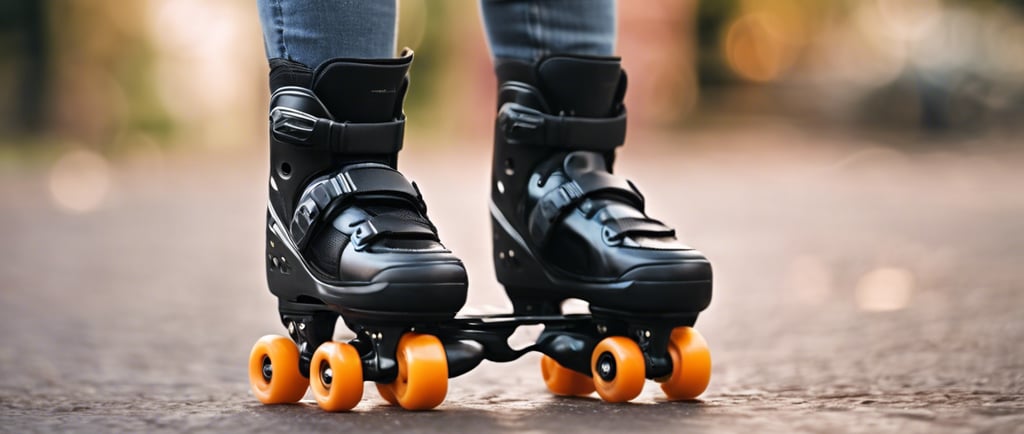Pros and Cons of Second-Hand or Preloved Inline Skates: Insights from Online Forums and Blogs
Hygiene issues are another critical aspect often highlighted by forum participants. Second-hand inline skates may harbor bacteria or fungi, especially in areas like the liners and boots. This can lead to unpleasant odors and, more importantly, pose health risks to the new user.
HEALTH AND SAFETYEDUCATIONAL
5/26/20244 min read


Advantages of Buying Second-Hand Inline Skates
Purchasing second-hand inline skates presents numerous benefits, as frequently highlighted in various online forums and blogs. One of the most compelling advantages is the significant cost savings. Preloved inline skates are often available at a fraction of the price of new ones, making them an attractive option for those who are budget-conscious or new to the sport. By opting for second-hand skates, individuals can experiment with different models and brands without a substantial financial outlay, allowing them to find the perfect fit and style before committing to a more expensive purchase.
Another notable benefit is the opportunity to acquire high-quality or rare models that are no longer available in stores. Enthusiasts often share their excitement over finding vintage or discontinued skates in excellent condition through second-hand markets. Such discoveries are particularly valued by collectors and those looking for unique equipment to enhance their skating experience.
Environmental sustainability is another critical advantage frequently discussed in online communities. Buying second-hand inline skates contributes to waste reduction and promotes recycling, aligning with the growing emphasis on eco-friendly consumer practices. This aspect is particularly appealing to environmentally conscious individuals who seek to minimize their ecological footprint.
Experienced skaters also point out that preloved skates often come "broken in," offering immediate comfort and performance advantages. Unlike new skates that may require a break-in period, second-hand skates have typically molded to a previous owner's feet, making them more comfortable for immediate use. This factor can be particularly beneficial for beginners who may find the initial break-in period of new skates uncomfortable.
Specific forum threads and blog posts provide detailed discussions on these advantages. For instance, a popular thread on Skater's Forum emphasizes the cost-effectiveness and environmental benefits of buying used skates. Similarly, a blog post on Inline Skating Insights highlights personal testimonials from skaters who have successfully found rare, high-quality models through second-hand purchases.
Disadvantages and Risks of Second-Hand Inline Skates
When considering the purchase of second-hand inline skates, it is crucial to be aware of several potential downsides and risks. Many users on online forums and blogs have shared their experiences, warning prospective buyers about the uncertainty regarding the condition of used skates. One significant concern is hidden damages that may not be immediately visible upon inspection. These damages could include cracks in the frame, worn-out wheels, or compromised bearings, all of which can affect the performance and safety of the skates.
Hygiene issues are another critical aspect often highlighted by forum participants. Second-hand inline skates may harbor bacteria or fungi, especially in areas like the liners and boots. This can lead to unpleasant odors and, more importantly, pose health risks to the new user. Cleaning and sanitizing the skates thoroughly is recommended, but it may not always be sufficient to eliminate all potential issues.
Wear and tear of essential components such as wheels, bearings, and boots are common concerns. Wheels and bearings, in particular, can degrade significantly over time, impacting the smoothness and efficiency of the ride. Replacing these parts can lead to additional costs, sometimes negating the financial benefits of buying second-hand. Forum discussions frequently emphasize examining these components closely and considering the total cost of potential replacements before making a purchase.
Another notable disadvantage is the lack of warranty or customer support for used inline skates. Unlike new products, second-hand skates typically do not come with any form of guarantee. This means that any issues arising post-purchase will have to be dealt with at the buyer's expense. Blogs and forums often suggest buying from reputable sellers or platforms that offer some form of buyer protection to mitigate this risk.
To navigate these challenges effectively, it is advisable to conduct thorough research and seek advice from experienced skaters. Checking multiple sources and reviews can provide a balanced perspective, helping buyers make informed decisions. By being vigilant and cautious, it is possible to find second-hand inline skates that offer good value without compromising on quality or safety.
Tips for Purchasing Quality Second-Hand Inline Skates
Acquiring second-hand or preloved inline skates can be a cost-effective way to enjoy the sport, but it requires a meticulous approach to ensure quality and safety. According to seasoned forum users and bloggers, the first and foremost step is to conduct a thorough inspection of the skates. Begin with a visual examination for any obvious signs of wear and tear. Pay special attention to the boot, frame, wheels, and bearings as these components are crucial for performance and safety.
Checking the condition of the wheels is essential. Worn-out wheels can significantly affect your skating experience. Rotate the wheels to see if they roll smoothly without any wobbling. Bearings should also be checked for rust or dirt. If they don’t spin freely, they might require cleaning or replacement. Inspect the boot for cracks, excessive wear, and the condition of the liners. Ensure the frame is intact and not bent.
Asking the seller detailed questions about the skates' history can offer valuable insights. Inquire about the frequency and type of usage. Skates used for aggressive skating, for instance, might have endured more stress compared to those used for recreational purposes. Knowing whether the skates have been regularly maintained can also be a good indicator of their remaining lifespan.
Forum users frequently recommend purchasing from reputable sources or community groups where seller accountability tends to be higher. Websites like eBay, Craigslist, or specialized inline skating forums often have reviews and ratings that can guide you toward trustworthy sellers. Local skate shops or community groups can also serve as reliable sources for preloved skates.
Once you've acquired your skates, proper sanitization and maintenance are paramount. Clean the liners and other components with mild detergent and ensure they are completely dry before use. Regular maintenance, such as rotating wheels and lubricating bearings, will extend the life of your second-hand skates, ensuring they remain safe and functional. For additional resources, forums like SkateLog and blogs such as InlineSkateWorld provide comprehensive guides and checklists to help you make informed decisions.
Contacts
information@skateshop.cc
Socials
Subscribe to our newsletter
Links
Shop Links
